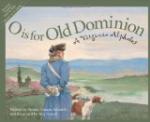But here were grown maize and wheat also; and to grind these Sir George built—over there on the point of the plantation—the first windmill in America.
In the eyes of the savages, he must have waxed to the stature of a great medicine man, when he made of wood the long arms that beckoned to the winds and made them come to grind his grain. Through all time, had not their fathers (or rather their mothers) had to steep grain for twelve hours; then laboriously pound it in stone mortars; and then sift it through baskets woven of river reeds?
Less matter for wonderment was that long-armed creature on the point of land to Hans Houten and Heinrich Elkens, sailing up the James in the White Dove with good Holland sack for barter. These sturdy mariners from the dyke-and-windmill country would regard the contrivance with more critical eyes than could the red man from the bow-and-arrow wilderness.
But we saw nothing of windmill or of palisaded village or of royal governor; and field and meadow and woodland all seemed too sleepy to tell us much about them. They only served to recall the tantalizing, broken bits that the records give of the picturesque life that was here—of colonial pomp and savage dignity, of London trade and Indian barter, of English games and merriment, of colonial trials and tragedies: all this of which we know, yet know so little.
And so we left the old plantation dreaming in the autumn sunshine—left it to the poets and to the story-tellers, who seem to have adopted it. They know how to weave the spells that bring back old manor-houses and gallants and ladies and tall London ships and the vanished scenes of love and of war. The place belongs to them; old Fleur de Hundred—half real and half ideal—an old-time bit of story-land.
CHAPTER XVIII
GADABOUT GOES TO CHURCH
It was the day before Thanksgiving when the houseboat Gadabout, with her good-byes all said, fished up her anchor from the river bottom in front of Weyanoke, and started off to find another place to drop it farther up the stream. She was ready for the holiday. The material for her Thanksgiving dinner was all aboard: part of it canned and boxed as the steamer had just brought it from Norfolk; and the rest of it, and the best of it, plump and gobbling on the stern.
But Gadabout’s preparations for the day had not stopped here. Not only had she provided the season’s feast, but she had diligently inquired of her chart and of her neighbours where she might take her family to church. The chart had told her of a little stream, called Herring Creek, a few miles farther up the James, and had shown her a mark upon the bank of the creek that it called Westover Church. The neighbours had said that the chart was right; and had added that the church was a colonial one still in use, and doubtless Thanksgiving services would be held there. Fortunately, Herring Creek was a stream that Gadabout had intended running into anyway, as it would be the anchorage most convenient to the next colonial estate that she should visit—the plantation of Westover from which the church had taken its name.




